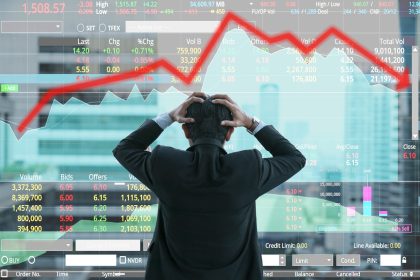The reason for income inequality no one’s talking about
The rules changed in 1993, exacerbating the already growing income inequality in America. Here’s why that must stop and how it can be stopped. Do your part.
This isn’t capitalism
On August 9, 2024, MarketWatch highlighted a startling disparity in income distribution, revealing that CEOs of S&P 500 companies earned 268 times more than the average worker in 2023. This phenomenon, aptly termed “CEO payflation,” signals a departure from the principles of pure capitalism. Rather than embodying the ideals of a free-market economy, this trend reflects a system increasingly driven by unequal power dynamics and skewed incentives.
To borrow from Judge Judy’s blunt wisdom, who titled her book Don’t Pee On My Leg and Tell Me It’s Raining, we must not be misled into believing that what we are witnessing is true capitalism. The United States’ current economic system, with its extreme disparities and entrenched inequalities, does not align with the foundational principles of capitalism envisioned by its intellectual architects.
Adam Smith, widely regarded as the father of capitalism, laid the groundwork for his economic theories in The Theory of Moral Sentiments before penning The Wealth of Nations. In his earlier work, Smith emphasizes the importance of the “truly virtuous person,” who pursues self-interest while considering the broader impact on society. This balance between personal gain and communal responsibility is essential to pure capitalism, yet it is a tenet that many modern business leaders and corporations seem to have overlooked.
Ruchir Sharma, in his insightful book What Went Wrong with Capitalism, identifies several contributing factors to the current economic malaise. He points to easy money policies, the ballooning national debt initiated during President Reagan’s tenure, and the reluctance of politicians and business leaders to allow the natural business cycle—complete with stock market corrections and mild recessions—to unfold. Moreover, the government’s failure to break up monopolies, protect small business patents, and the expanding influence of the Central Bank have all played a role in distorting the market.
These factors have exacerbated income inequality and led to a system that more closely resembles an oligopoly or plutocracy than an actual capitalist society. The concentration of wealth and power in the hands of a few, coupled with the erosion of competitive market principles, underscores that the economic system in place today is far removed from the capitalist ideals that Adam Smith once championed.
Shareholders over workers
In 2012, the Center for Economic Policy Research released a study that starkly highlighted the growing disparity in income inequality. The study revealed that if the minimum wage had risen at the same rate as worker productivity from 1945 to 1968—from $22 to $33 per hour—it would have reached $22 per hour. More strikingly, if the minimum wage had kept pace with the astronomical increases in corporate executive income during the same period, it would have been $33 per hour.
The implications would have been profound if the minimum wage had been set at even $22 an hour. It would have reduced income inequality and significantly boosted Americans’ purchasing power, allowing them to buy more goods and services their employers offer. This, in turn, would have infused real money into the economy, fueling growth and improving the quality of life for the average American. Simply put, a higher minimum wage would have a ripple effect, benefiting not just individual workers but the economy as a whole.
However, the reality is far different. The same “free market” principles that justified a meager 0.84% annual wage increase for the average worker between 1982 and 2012 also justified a staggering 10.20% yearly increase for corporate executives over the same period. This stark contrast underscores a growing inequality that has become entrenched in the economic fabric of the United States.
Research suggests that employee commitment is crucial to a company’s financial performance. A 2010 study found that companies with highly committed employees outperformed the total stock market index, delivering shareholder returns 19% higher than average. In contrast, companies with disengaged employees saw shareholder returns 44% lower than average. Employee commitment directly impacts a company’s stock price and overall financial health, and employees are more likely to stay committed when they feel they are being treated equitably.
The financial implications of not maintaining employee commitment are significant. Studies indicate that replacing a “key person” can cost a company between 70% and 200% of that person’s total compensation, factoring in the expenses related to recruiting, hiring, and training a replacement. Thus, the actual cost of income inequality extends beyond the wage gap—it also drains corporate resources and undermines long-term profitability.
Historically, corporate executives recognized that employees are the heart and soul of any company. This belief was not just theoretical; it was a guiding principle as recently as 1971 when Thomas J. Watson, Jr., then President of IBM, spoke about the importance of balancing a company’s interests with those of the country. However, over the past 20 to 30 years, a fundamental shift in corporate thinking has occurred, one that prioritizes shareholder value above all else. This shift, which has exacerbated income inequality, can be traced back to September 1970, when economist and University of Chicago professor Milton Friedman published his influential essay, “The Social Responsibility of Business is to Increase Profits,” in The New York Times Magazine.
Friedman’s philosophy, later embraced by President Ronald Reagan, argued that a corporate executive is primarily the employee of the business owners. Therefore, according to this logic, the executive’s primary responsibility is to maximize profits for shareholders, often at the expense of other stakeholders, including employees. While this approach may seem logical within the framework of a free-market system, the rules changed in 1993, further widening the gap between the wealthy and the rest of society and solidifying the trend of increasing income inequality.
In the years since Friedman’s essay, this profit-above-all mentality has undermined the social contract between employers and employees and contributed to the economic disparities that now define modern American capitalism. Focusing on short-term profits over long-term sustainability has come at a significant cost to workers and the broader economy.
The sweetest boss on Earth
In grade school, I was assigned a paper on a prominent American figure, past or present. Given my proximity to Hershey, PA, and my early love for chocolate—long before I discovered the blissful pairing of chocolate and red wine—I chose to write about Milton Hershey, the founder of The Hershey Chocolate Company.
Milton Hershey believed that his employees were his greatest asset. He treated them with fairness and respect, operating on the principle that well-treated employees would, in turn, give their best to the company. Hershey’s commitment to his workforce was evident in the town he created: Hershey, Pennsylvania. This town wasn’t just a place to work; it was a community complete with schools, a shopping center, a theme park, and more—designed to provide his employees with the best possible work-life balance.
Years after writing that paper, I attended graduate school for business, where the idea that a company’s greatest asset is its employees was further reinforced. This mutually beneficial approach cultivates a workplace that attracts and retains top talent and fosters a more satisfied and loyal customer base. When treated equitably, employees are more motivated, productive, and committed to the company’s success. This, in turn, leads to better customer service, higher-quality products, and stronger customer loyalty.
In the competitive marketplace, companies vie for both top talent and customers. Viewing and treating employees as a company’s most valuable asset is one of the most effective strategies for achieving success in both areas. Equitably treated employees contribute to a positive workplace culture and drive the company’s ability to satisfy and grow its customer base, creating a cycle of success that benefits everyone involved.
The (rigged) new economy
In 1993, the passage of U.S. Tax Code 162, coincidentally the same year that NAFTA was signed into law, marked a significant attempt to address income inequality and curb excessive corporate executive pay. The 103rd Congress, then controlled by Democrats, passed this legislation, which President Bill Clinton signed into law. The new tax code sought to tie executive compensation more closely to corporate performance, particularly shareholder value.
For those not steeped in the jargon of Washington, U.S. Tax Code 162 essentially capped the annual cash salary of the top five highest-paid executives at publicly traded companies at $1 million. However, there was a significant loophole: stock compensation was left unlimited. The rationale was that by linking executive pay to stock performance—supposedly a reflection of the company’s overall performance—executives would be incentivized to act in the best interests of shareholders and the company itself. Theoretically, this alignment would be mutually beneficial, holding corporate leaders accountable to shareholders and employees.
Since 1993, the Securities and Exchange Commission (SEC) has implemented additional regulations to ensure corporate executives remain accountable to shareholders. However, these measures have had unintended consequences. Far from reinforcing a proper “free-market” system, these government interventions have arguably distorted the market and exacerbated income inequality, opening a Pandora’s box that continues to harm the vast majority of Americans—the so-called “99%.”
As a result of these changes, corporate executives’ perspectives have shifted dramatically. Employees are no longer viewed as valuable assets, let alone the most important ones. Instead, employees are increasingly seen as liabilities—costs to be minimized rather than partners in the company’s success. Labor has become commoditized, a resource to be squeezed for maximum output at the lowest possible cost.
“There’s never been less pressure on employers to give raises, while at the same time, there’s so much pressure to control costs,” says Dave Van De Vort, a principal with Buck Consultants. “Employers have learned they can squeeze more and more out of their workforce.” This shift in corporate mentality—fueled by regulations intended to make executives more accountable—has contributed to the widening gap between the wealthy and the rest of society. It has also undermined the foundational idea that a company’s success is built on the contributions of its employees.
The relationship between employers and employees has fundamentally changed in the decades since the passage of U.S. Tax Code 162. The focus on short-term profits and shareholder value, driven by stock-based compensation, has eroded the traditional view that employees are a company’s heart and soul. Instead, they are often treated as mere cogs in a profit-driven machine, a shift that has deepened income inequality and strained the social contract that once underpinned American capitalism.
Unfree market growth
Steven Pearlstein captured the essence of a growing problem in his September 2013 Washington Post article, “How the Cult of Shareholder Value Wrecked American Business.” He pinpointed the root causes of many economic challenges facing the United States today, including slow growth, rising inequality, recurring corporate scandals, extreme economic cycles, chronic underinvestment in research and development, worker training, and public infrastructure. According to Pearlstein, these issues can be traced back to the pervasive ideology that places shareholder value above all else.
Consider the issue of corporate taxes. While the federal corporate tax rate is officially set at 35%, the reality is far different for most large U.S. corporations. In 2010, the Government Accountability Office reported that major corporations paid an effective federal tax rate of 12.6% and 22.7%—a significant reduction from the statutory rate. This disparity highlights how companies have strategically minimized their tax liabilities, often at the expense of the public.
For years, companies have been reducing their research and development investment, instead relying on government-funded initiatives to drive innovation. This reduction in corporate R&D spending means that taxpayer money, rather than corporate profits, increasingly funds the technological advancements that fuel economic growth. At the same time, companies have cut their workforce and kept wages stagnant, pushing more and more Americans to rely on government assistance programs like SNAP, WIC, and Medicaid. This shifting of responsibility—from corporations to the government—has exacerbated income inequality and strained public resources.
The result of these reduced corporate taxes and expenses is a significant increase in profits, which, rather than being reinvested in the business or distributed to employees, are used to boost shareholder value. Over the past decade, approximately 94% of Fortune 500 companies’ profits have been spent on share buybacks and dividends. This amounts to anywhere between $300 billion and $600 billion annually that could have been used for employee compensation, future growth investments, or even to help fund public services. Instead, this money is funneled into the pockets of shareholders and corporate executives, further widening the gap between the wealthy and the rest of society.
Today, U.S. companies’ primary sources of capital generation are not the creation of innovative products or services, new inventions, or breakthroughs in science and technology. Instead, they come from retained earnings, credit, and debt financing. This shift from value creation to financial engineering reflects a broader trend in corporate America. Companies have increasingly relied on creative accounting methods—Bill Gross, the former head of Janus (previously PIMCO), famously called “balance sheet alchemy and financial wizardry”—rather than sound business management practices to boost their bottom lines.
This transformation can be traced back to 1993 when U.S. Tax Code 162 and related policies fundamentally altered the role of the corporate executive. No longer merely the employee of the company’s owners, the executive has become both an employee and a partial owner, with a solid incentive to prioritize shareholder value above all else. This shift has narrowed focus on short-term profits at the expense of long-term sustainability, innovation, and employee welfare, thereby deepening income inequality.
The shareholder primacy ideology has not only distorted corporate governance but has also eroded the broader social contract. By prioritizing shareholders—often at the expense of employees, customers, and the community—corporate executives have contributed to an economic system that increasingly serves the interests of the few at the cost of the many. The consequences are clear: a more unequal society, weakened social cohesion, and an economy that, while generating enormous wealth for some, fails to provide broadly shared prosperity.
It’s time for a [better] strategy
Tying corporate executive compensation to performance incentives is, at best, a dubious strategy. Research suggests that “changes in [company] performance account for only 4% of the variance in corporate executive [compensation].” This statistic reveals a significant disconnect between a company’s performance and its executives’ compensation, demonstrating that history has shown minimal causation.
Making matters worse, the research of Roger Martin and Lynn Stout on the benefits of linking executive performance to shareholder value has shown that this approach has not effectively controlled executive compensation, as the 103rd Congress had hoped. Nor has it yielded significant returns for shareholders. In 1970, stock options accounted for only 1% of Fortune 500 chief executives’ compensation, with the average CEO salary at $700,000. By 2012, stock and stock options comprised 80% of executive compensation, which had ballooned by over 1,800% to an average of $12.9 million.
Martin and Stout also highlight a fundamental flaw in this system: With the average corporate executive tenure being just four and a half years and the average stock ownership tenure being a mere four months, executives have little incentive to focus on the company’s long-term growth and success. Instead, they are more likely to engage in practices that boost short-term stock prices, often at the expense of sustainable business practices and long-term value creation.
The long-term success of any company relies far more on innovation, the quality of its products and services, and a solid business strategy than on simply meeting quarterly earnings expectations. As Keld Jensen aptly stated, “Maximizing returns is an outcome, not a strategy.” When executive compensation is heavily tied to stock performance, it encourages a short-term mindset that prioritizes immediate gains over the sustained growth and health of the company. This approach can lead to underinvestment in research and development, neglect of employee welfare, and a disregard for the long-term consequences of business decisions.
Moreover, the rapid increase in executive compensation has exacerbated income inequality and contributed to a widening gap between the wealthy and the rest of society. While shareholders might see short-term benefits from rising stock prices, the broader economy and society pay the price through diminished innovation, lower job creation, and increased economic instability.
In essence, the current system of linking executive pay to shareholder value has not only failed to achieve its intended goals. Still, it has also introduced a host of unintended negative consequences. It has shifted corporate priorities away from long-term value creation and toward short-term profit maximization, undermining the very foundation of sustainable business practices. For companies to thrive in the long run, they must refocus on the fundamentals—innovation, quality, and strategy—rather than being driven by the narrow pursuit of maximizing returns for a select few.
Reducing income inequality
America’s political and business leaders must stop rigging the game to favor the wealthy while increasing income inequality. To maintain our position as the world leader in business, we must create an environment that fosters innovation, technological advancements, and progress in science and engineering. Moreover, we must ensure that all citizens, regardless of their position in society, can reap the financial rewards of their hard work.
Addressing income inequality can boost the buying power of average Americans, infuse more money into the economy, and create a more equitable society. This approach isn’t about promoting unmitigated capitalism or sliding into socialism—it’s about ensuring that all employees share in the rewards of a prosperous company, just as they bear the brunt of any negative consequences. It’s a call for fairness and balance, where the success of a business benefits everyone involved, not just the top executives and shareholders.
Those who advocate rigidly for either extreme—unfettered capitalism on one side or socialism on the other—often have an ulterior motive. They know that we are more easily controlled and manipulated when divided. These ideologies’ polarization distracts us from the real issue: the need for a system that rewards hard work and innovation across the board, not just at the top.
This systemic imbalance is why it has become so difficult for the average American to stay debt-free. As wages stagnate and costs rise, the promise of upward mobility—the cornerstone of the American Dream—becomes increasingly out of reach. To reverse this trend, we need policies promoting shared prosperity, where the fruits of a thriving economy are distributed more equitably, giving everyone a fair chance at financial security.
The path forward requires a renewed commitment to the principles of fairness and opportunity. It demands that we challenge the status quo and push for reforms that ensure the benefits of economic growth are felt by all, not just a privileged few. By uniting around these common goals, we can only build a more robust, resilient economy that truly works for everyone.
Get more help to fight income equality
Read the full article here

















